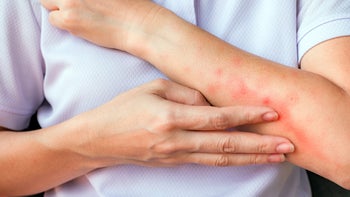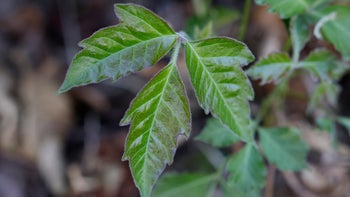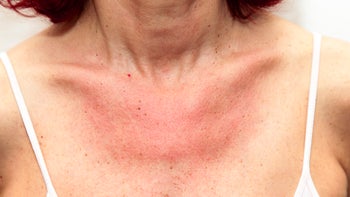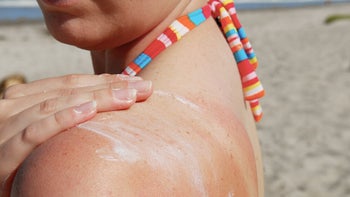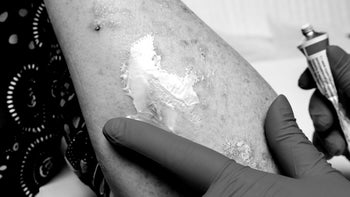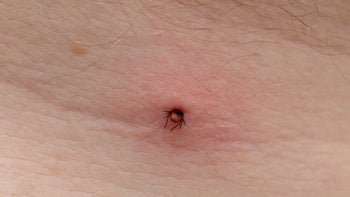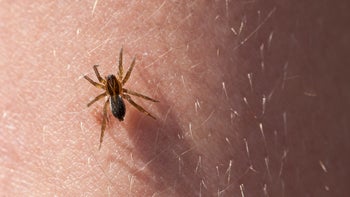
Oatmeal Baths: 5 Skin-Soothing Benefits and How to Make One
Key takeaways:
Soaking in oatmeal baths has long been recognized as an effective way to soothe and moisturize the skin.
Adding finely ground oatmeal to warm baths can help soothe inflammation caused by common skin conditions, such as acne, eczema, and psoriasis.
Board-certified dermatologist Debra Jaliman, MD, has a step-by-step guide on how to prepare one right at home using colloidal oats.
Table of contents

Oatmeal isn’t just a hearty breakfast — it can also be a major boon for skin health. However, you’re not going to receive skin-soothing benefits from sitting in a tub of cooked oats. Well, you might, but that would be a major waste of both food and time.
Instead, dermatologists recommend adding what’s called colloidal oatmeal, or finely ground oatmeal, to baths. This type of oatmeal has long been used as a method to treat skin conditions and diseases. In fact, it was used to soothe dry, itchy, and inflamed skin as far back as 2000 B.C. in Arabia and Egypt. More recently, in 2003, the FDA gave its seal of approval, deeming it a skin protectant.
So that you can get the most out of using colloidal oatmeal in your own at-home treatments, we’ve asked Debra Jaliman, MD, a board-certified dermatologist in New York City, to give us her recipe for the perfect oatmeal bath.
Search and compare options
What are the benefits of an oatmeal bath?
Speaking with GoodRx, Dr. Jaliman explained why oatmeal is so good for the skin.
“It stops the redness in the skin and also helps with itching,” she said, referring to oatmeal’s anti-inflammatory properties. “It also has antioxidant effects and moisturizing benefits.”
Below, we’ve outlined five specific skin benefits of colloidal oatmeal — whether it’s in a bath or a topical salve — with even more insight from the dermatology expert.
1. It can help stop itching and irritation
Colloidal oatmeal can help quell itching and irritation caused by skin conditions, according to Dr. Jaliman, including:
Viral rashes
Shingles
Dr. Jaliman said that, in addition to baths, lotions and moisturizers that contain colloidal oatmeal can also do the trick. And there’s research to back that up.
Read more like this
Explore these related articles, suggested for readers like you.
In a small-scale study, researchers looked at the effects topical colloidal-oatmeal cream had on people with chronic hand eczema. They found that, after 2 weeks, the group of participants who used the oatmeal-based cream had less itching compared to those who used a nonoatmeal hand cream.
Because of its anti-itch and anti-irritation benefits, colloidal oatmeal can even be helpful for pesky bug bites. It’s a safe and effective compliment for treatments like Benadryl, especially for little kids.
2. It locks in moisture
Finely ground oatmeal is considered an emollient, which is a substance that softens and moisturizes the skin.
Studies have shown that moisturizers with colloidal oatmeal are more effective at treating people with moderately dry and severely dry skin than those without.
For kids or adults who don’t want to use or dislike the feeling of lotion — which is common among people on the autism spectrum and with other sensory sensitivities — oatmeal baths are a great alternative. This can be especially helpful in the winter months, when dry skin worsens.
3. It can help alleviate symptoms of psoriasis
As Dr. Jaliman noted above, colloidal oatmeal is known to have antioxidative and anti-inflammatory effects on the skin. This can help provide relief from certain chronic skin diseases, such as psoriasis.
Psoriasis is an autoimmune disease that causes patches of thick red, skin and silvery scales. It affects more than 7.5 million adults in the U.S. Apart from genetics and environmental factors, psoriasis is believed to be caused by chronic inflammation that leads to the sustained production of pro-inflammatory cytokines (proteins that cause inflammation) and oxidative stress.
Research suggests that the topical use of colloidal oatmeal can help combat pro-inflammatory cytokines and, in part, reduce the prevalence of scaling skin, dryness, and itching.
4. It can help cleanse the skin
Face washes made with colloidal oatmeal can be supportive for sensitive skin, as oatmeal is a mild cleanser. This is largely because oats contain saponins, compounds found in certain plant foods, which get their name from the soap-like foam that forms when they’re added to water.
If your skin is prone to acne, opting for a gentle, oatmeal-based cleanser could help reduce irritation and hydrate your skin. This can be especially helpful if you’re using an aggressive acne treatment that irritates the skin.
5. It’s affordable
There are a lot of products out there that can help relieve itching and provide moisture. But oatmeal has many of them beat in at least one major category: affordability.
About 42 oz (approximately 14 cups) of quick oats costs roughly $2. The same amount of old-fashioned rolled oats can cost close to $3. Considering you’ll use about 1 cup of oatmeal per bath, that’s 14 baths for less than $3.
How to make an oatmeal bath
Preparing an oatmeal bath is really simple. You just want to make sure you use lukewarm water. Water that’s too hot can dry out your skin and prompt further irritation.
Dr. Jaliman suggests following this step-by-step guide to prepare an oatmeal bath:
Take 1 cup of uncooked oatmeal (any unflavored type is OK).
Put it in a blender or food processor.
Grind it into a fine powder.
Place the powder in a bathtub full of lukewarm water.
Soak in the mixture for about 15 minutes.
Rinse off with lukewarm water to remove any flakes.
Pat your skin dry.
Apply an unscented moisturizer.
If you don’t have a blender or food processor at home, you can also buy colloidal oatmeal at your local pharmacy.
Do oatmeal baths have any side effects?
Dr. Jaliman said that there isn’t a risk of adverse effects with oatmeal baths, adding that there have been “no reported allergic reactions.”
In fact, a 2012 review that analyzed the effects of oatmeal-containing products on skin found that nearly 446,000 creams, cleansers, and lotions sold during a 3-year period didn’t cause allergic reactions in the study participants. And the participants who typically experienced dryness even reported having more moisturized skin up to 2 weeks after discontinuing the use of the products.
Still, it’s a good idea to reach out to your healthcare professional or dermatologist if you’re unsure if using colloidal oatmeal is right for you.
Frequently asked questions
Yes, it’s OK to add oatmeal to your bath every day. Make sure your water isn’t too hot. Hot water can dry out your skin. If you have certain skin conditions, you might not want to take a bath each day, to avoid drying out your skin more. Your dermatologist can help you decide how often to take oatmeal baths.
Yes. Epsom salt baths may ease itching from psoriasis. If you have psoriasis, adding colloidal oatmeal can help boost the soothing effects of an Epsom salt bath.
It depends on how finely you grind your oatmeal, the age and configuration of your plumbing and how much other debris (like hair) goes down your drain. You can place a strainer over your drain when you release the water to protect your plumbing. This will catch most of the oatmeal as the water drains out.
The bottom line
Taking oatmeal baths can be an effective way to soothe and moisturize skin, especially for those who have certain skin conditions and rashes. While colloidal oatmeal has long been studied as an irritation-reducing remedy, speaking with a healthcare professional before the use of any new treatment is always recommended.
Why trust our experts?


References
Allais, B., et al. (2020). Colloidal oatmeal part I: History, basic science, mechanism of action, and clinical efficacy in the treatment of atopic dermatitis. Journal of Drugs in Dermatology.
Armstrong, A. W., et al. (2021). Psoriasis prevalence in adults in the United States. Journal of the American Medical Association Dermatology.
Criquet, M., et al. (2012). Safety and efficacy of personal care products containing colloidal oatmeal. Clinical, Cosmetic, and Investigational Dermatology.
Ilnytska, O., et al. (2016). Colloidal oatmeal (Avena sativa) improves skin barrier through multi-therapy activity. Journal of Drugs in Dermatology.
Kalaaji, A. N., et al. (2014). A randomized controlled clinical study to evaluate the effectiveness of an active moisturizing lotion with colloidal oatmeal skin protectant versus its vehicle for the relief of xerosis. Journal of Drugs in Dermatology.
Katsimbri, P., et al. (2021). The effect of antioxidant and anti-inflammatory capacity of diet on psoriasis and psoriatic arthritis phenotype: Nutrition as therapeutic tool? Antioxidants.
Kurtz, E. S., et al. (2007). Colloidal oatmeal: History, chemistry and clinical properties. Journal of Drugs in Dermatology.
Reynertson, K. A., et al. (2015). Anti-inflammatory activities of colloidal oatmeal (Avena sativa) contribute to the effectiveness of oats in treatment of itch associated with dry, irritated skin. Journal of Drugs in Dermatology.
Shi, J., et al. (2004). Saponins from edible legumes: Chemistry, processing, and health benefits. Journal of Medicinal Food.
Sobhan, M., et al. (2020). The efficacy of colloidal oatmeal cream 1% as add-on therapy in the management of chronic irritant hand eczema: A double-blind study. Clinical, Cosmetic and Investigational Dermatology.
U.S. Food and Drug Administration. (2003). Skin protectant drug products for over-the-counter human use; final monograph. Federal Register.












